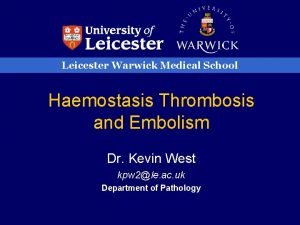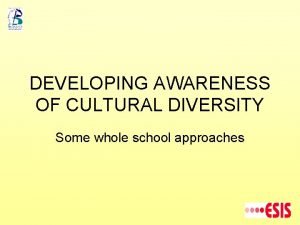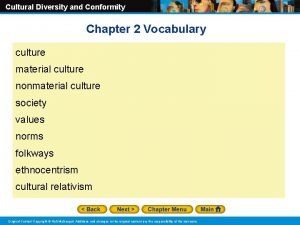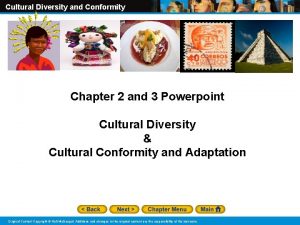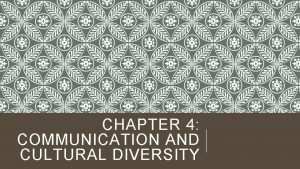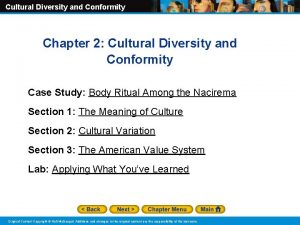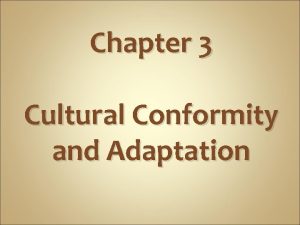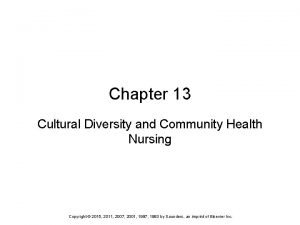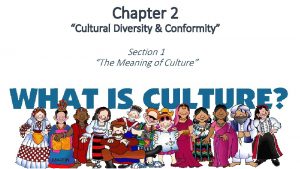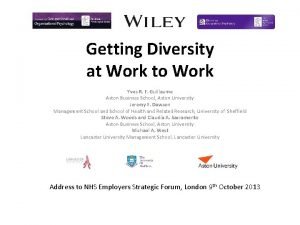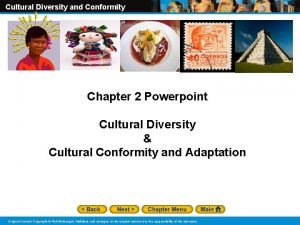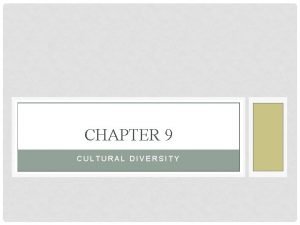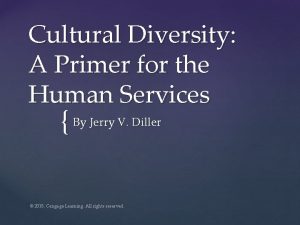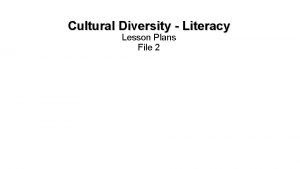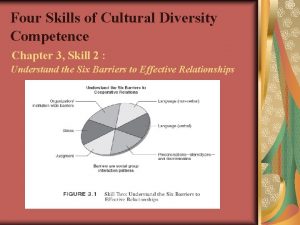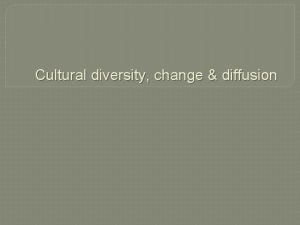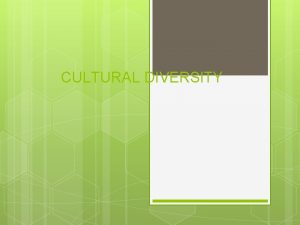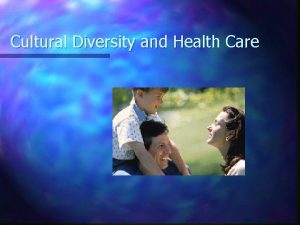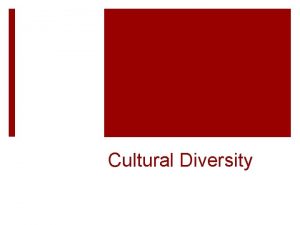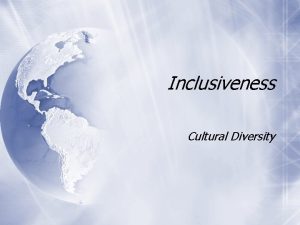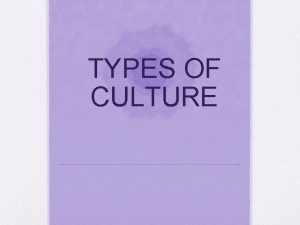Leicester Warwick Medical School Cultural diversity and general







































- Slides: 39

Leicester Warwick Medical School Cultural diversity and general practice Dr Nisha Dogra Senior Lecturer in Child and Adolescent Psychiatry Greenwood Institute of Child Health

Presentation plan Defining cultural diversity Relevance of diversity education Effectiveness of diversity training Issues to consider (training; workforce issues; ethnic specific services) What do patients want? Self-reflection Summary

Your sense of self Where were you born? 1. Where were your parents born? 2. What is your nationality? 3. Do you feel you belong to an ethnic group? If yes which group do you feel you belong to? If not, can you give your reasons as to why you do not feel you belong to an ethnic group? 5. Do you feel you belong exclusively to one culture? If yes which one? If no what cultures do you feel you belong to? 6. What for you defines your sense of cultural belonging?

What does cultural diversity actually mean? Culture is not a value free concept. Many definitions of this The concept of culture, cultural identity or belonging to a cultural group involves a degree of active engagement by individuals and is a dynamic process. Problematic to assign cultural categories externally and based only on certain characteristics. Frosh (1999: 413) described the view that identity draws from culture but is not simply formed by it.

Association of American Medical Colleges (AAMC): “Culture is defined by each person in relationship to the group or groups with whom he or she identifies. An individual’s cultural identity may be based on heritage as well as individual circumstances and personal choice. Cultural identity may be affected by such factors as race, ethnicity, age, language, country of origin, acculturation, sexual orientation, gender, socioeconomic status, religious/spiritual beliefs, physical abilities, occupation, among others. These factors may impact behaviours such as communication styles, diet preferences, health beliefs, family roles, lifestyle, rituals and decision-making processes. All of these beliefs and practices, in turn can influence how patients and heath care professionals perceive health and illness and how they interact with one another” (AAMC, 1999: 25).

Why this definition? • • This is a patient-centred/individual-centred definition and can be applied to clinical situations. Suggests that individuals draw upon a range of resources Through the interplay of external and internal meanings construct a sense of identity and unique culture. Patients define which aspect of their cultural belonging is relevant at any particular point This may change in different clinical contexts, at different stages of an individual’s life and may also depend on the clinical presentation itself

Diversity • • Diversity should perhaps be a more straightforward term However, again this term is used imprecisely. May mean diversity of ethnicity for which the term ‘multiculturalism’ is often used (e. g. Culhane-Pera et al 1997, Loudon et al, 2001). May also cover the range of groups within society and so includes groups identified with characteristics other than ethnicity, such as sexual orientation. In other cases, it covers a much broader range of difference relating to individual characteristics beyond ethnicity.

Cultural competence Cross et al (1989) stated: “The model called “cultural competence” …involves systems, agencies and practitioners with the capacity to respond to the unique needs of populations whose cultures are different than that which might be called “dominant” or “mainstream” American. The word culture is used because it implies the integrated pattern of human behaviour that includes communications, actions, customs, beliefs, values and institutions of a racial, ethnic, religious or social group. The word competence is used because it implies having the capacity to function in a particular way: the capacity to function within the context of culturally integrated patterns of human behaviour as defined by the group. While this publication focuses on ethnic minorities of colour, the terminology and thinking behind this model applies to each person – everyone has or is part of a culture” (1989: 3). •

Use of terms Although the term is widely used, it often has different meanings (Henry J Kaiser Family Foundation 2003). No readily consistently used definitions regarding race and ethnicity (Bradby, 2003). For example, in the US the concept of race is still perceived more as a biological characteristic, whereas in the UK there is greater acceptability that it is a social construct (Dogra and Karnik, 2004). Two studies (Dogra, 2004 and Dogra and Karnik, 2004) found that whilst there is some consistency in how culture is defined, there is little consistency in how it is subsequently used by a range of professionals and users. In the same studies, there was even less clarity about the terms, race and ethnicity.

Your sense of self Where were you born? 1. Where were your parents born? 2. What is your nationality? 3. Do you feel you belong to an ethnic group? If yes which group do you feel you belong to? If not, can you give your reasons as to why you do not feel you belong to an ethnic group? 5. Do you feel you belong exclusively to one culture? If yes which one? If no what cultures do you feel you belong to? 6. What for you defines your sense of cultural belonging?

Why is diversity important to health care delivery? There are several key reasons, which include: - - Increasing diversity of populations (patients and workforce) There is increasing albeit limited evidence to show that taking a patient-centred approach which acknowledges patient perspectives and actively involves them in their own care improves outcomes Huge disparities in care accessed Disparities beyond the point of access Differential outcomes Legislative frameworks

Effective communication Evidence shows that communication skills diminish malpractice risk Enable the patients’ problems to be better identified with reduction in misdiagnosis and misunderstandings Increased compliance Improved outcomes including patient satisfaction (Levinson et al, 1997) Note however, the above does not just apply to communication with patients but with our staff and colleagues

Problems that may arise · Lack of knowledge – resulting in an inability to recognise the differences · Self-protection/denial – leading to an attitude that these differences are not significant, or that our common humanity transcends our differences · Fear of the unknown or the new – because this is challenging and perhaps intimidating to understand something new that does not fit into one’s worldview Feeling of pressure due to time constraints – which can lead to feeling rushed and unable to look in depth at an individual patient’s needs

In turn may lead to · Patient-provider relationships are affected when understanding of each other’s expectations is missing • Miscommunication • The provider may not understand why the patient is non-compliant, how decisions in the family may be made especially about health care The patient may reject the healthcare provider because of the non-verbal cues given by the provider (Diversity. Rx, 2001). Conflict or isolation within staff groups

Relevance to general practice The above issues are compounded by the fact that we usually See members of the same families Different relationship with the community May be an integral part of the community AND The diversity within general practice is changing More applicants from the Indian sub-continent (remember 2 way street – knowing about diversity from their perspective but also supporting them to work with diverse population they may have little experience of Course organisers have responsibility to recruit fairly – how can they do that if are unaware of different value bases etc

Published evidence Very few programmes have been subject to evaluation beyond subjective student feedback. Exceptions are Mao et al, 1988 Copeman, 1989 Rubenstein et al, 1992 Culhane Pera et al 1997 Majumdar et al 1999 and Dogra 2001 All used pre- and post-teaching questionnaires. All reported some degree of ‘positive’ changes in student perspectives but there was little follow up

Published evidence Webb and Sergison (2003) found that participants stated that they found the training useful In a follow up study commented on how they thought their own behaviour had changed. Examples of changes of practice included using more culturally appropriate pictures for the ward; not using minors as interpreters.

Published evidence A systematic review of five interventions to improve cultural competence in healthcare systems including cultural competency training for healthcare providers was undertaken by Anderson et al (2004). Identified only one study that they felt had a fair quality of execution Concluded that the evidence was insufficient.

Areas that need consideration · How patients are viewed; · Training models; · Whether or not there needs to be greater clarity regarding service models, and · What should policy say and · What should practitioners and services do to make a difference.

Ideal types for cultural expertise and cultural sensibility Using Weber’s construct of ideal types, the concepts of cultural expertise and the proposed cultural sensibility are compared with regard to several characteristics.

Cultural expertise A dictionary definition of expertise (Thompson, 1995) is expert skill, knowledge or judgement, with expert being defined as having special skill at a task or knowledge in a subject. There is notion that through learning knowledge about ‘other’ cultures, one can develop ‘cultural expertise’. This model encompasses programmes trying to achieve ‘cultural competence’

Cultural sensibility A dictionary definition of sensibility is openness to emotional impressions, susceptibility, and sensitiveness. It relates to a person’s moral, emotional or aesthetic ideas or standards. Cultural sensitivity is the quality or degree of being sensitive which is more limited than sensibility, and does not take into account the interactional nature of sensibility. If one is open to the outside, one might reflect and change because of that experience.

Item Cultural expertise Cultural sensibility Conception of culture Culture is an externally recognised characteristic Culture is an internally constructed sense of self Static One-dimensional Race/ethnicity emphasised Dynamic/fluid Multidimensional Race is one aspect

Item Cultural expertise Cultural sensibility Learning process Acquisition of knowledge Acquisition of principles (method) Cultural focus Majority view of other cultures dominant Majority Whites need to consider needs of minorities No focus on particular groups – all individuals need to consider needs of others Educational process

Item Cultural expertise Cultural sensibility Role of experts There are those who are experts on understanding cultural perspectives of certain groups No one individual has ownership of expertise of others with respect to identification of cultural belonging

Item Cultural expertise Cultural sensibility Nature of content Parochial Specific Global Non-specific Teaching focus Groups (treats people as groups) Individuals (views individuals as potentially parts of different groups in different contexts Curriculum Fact acquisition to gain body of knowledge Self-reflection and self-awareness of students Educational content

Item Cultural expertise Outcome in clinical Practical in that practice have facts about other cultures Applicability Cultural sensibility Practical in that have a method of inquiry to be aware that others may have different perspectives More critical and self reflective Capacity for dialogue Learning can only Learning can apply be used for cultural to any context issues where there is difference be it cultural, gender, education

Increasing the minority presence in the workforce Assumption that people form similar ethnic backgrounds have a common understanding based on one characteristic. Danger that seeing groups as homogenous promotes thinking in stereotypic ways rather than about individuals. The discussion also often appears to be one-sided, as if only the majority have negative views about minorities (Sue, 1991). May be unwise to make assumptions that minority professionals will understand the experience of other minority individuals (Gurung and Mehta, 2001).

What do healthcare providers think? Study aim: to explore what professionals working in a CAMHS thought of provision of mental health services to diverse groups and what their training needs in diversity might be. No discernable pattern between sections of the sample, although this is clearly limited by the sample size and may not be surprising given the common professional context. Study limitations

Perceptions of diversity Majority had a fairly traditional positivist view of culture Just under a quarter related diversity to individual sense of self. Implications for clinical practice. Contrast to family therapy approaches which has now developed a much, more social constructionist perspective (Carr, 2000). Would GPs be any different?

Improvements to the service As identified by Draper et al (2003) staff were readily able to identify areas for improvement Two suggested that ethnic monitoring would be helpful, was not qualified how this might be helpful. Staff also made comments about learning from the community and engaging with them although few discussed specifics. Consistent with findings relative to community perceptions (Dogra et al, submitted), staff did feel that CAMHS needed to promote and advertise its services better.

Views about ethnic specific services Majority of staff perceived disadvantages and advantages of ethnic-specific services 3 respondents expressed discomfort at the idea, feeling it encouraged stereotypical thinking. 3 felt that ethnic-specific services were inappropriate, as we should be working towards improving services for everyone.

Training issues Majority of staff had been trained but only a minority were thought training was useful. Criticisms that: Diversity training often assumes race to be the most important factor Often reinforced or created stereotypes. Not felt to be engaging

Training needs Majority identified needing more information about ‘specific groups’ such as Muslims or Blacks. Internal inconsistency in that viewed diversity as related to individuals but wanted information about groups. A smaller number felt awareness was needed. 3 said keeping an open mind was the most important issue Generally staff demonstrated little clarity or certainty about training needs which reflects the confusion there is in this area.

Training needs Majority identified needing more information about ‘specific groups’ such as Muslims or Blacks. Some of these were internally inconsistent in that they viewed diversity as related to individuals but wanted information about groups. A smaller number felt awareness was needed. Three identified very clearly that keeping an open mind was the most important issue Generally staff demonstrated little clarity or certainty about training needs which reflects the confusion there is in this area.

Training needs Culhane-Pera found that residents were resistant to training Tang et al found attendings less comfortable than residents and students regarding issues of diversity AMA found that physicians wanted information rather than to think about changing their practice What do you think GPS might identify as their needs?

Policy Most policy in this area is not evidence based Political agendas foremost Policy may be difficult to implement in any meaningful way

What has been covered? Defining cultural diversity Relevance of diversity education Effectiveness of diversity training Issues considered - training; workforce issues; ethnic specific services) What do patients want? Staff views Finally a chance for some reflection on your own practice

Reflecting on your own practice Think about how you view culture and sense of identity given the frameworks presented Justify your position in the context of your professional role Reflect on your own clinical and educational practice Evaluate how your own views influence the choices you offer your trainees or patients How often are you genuinely interested in asking individual patients what they might need? How often do you assume that the needs of patients or colleagues are already known on the basis of their diagnosis, ethnicity, gender or any other factor? What three things could you do to change your own practice?
 Leicester warwick medical school
Leicester warwick medical school Leicester warwick medical school
Leicester warwick medical school Gerald saldanha
Gerald saldanha Leicester warwick medical school
Leicester warwick medical school Leicester warwick medical school
Leicester warwick medical school Whole school approach to cultural diversity
Whole school approach to cultural diversity Leicester high school athletics
Leicester high school athletics Krishna avanti leicester term dates
Krishna avanti leicester term dates Genetic diversity vs species diversity
Genetic diversity vs species diversity Genetic diversity vs species diversity
Genetic diversity vs species diversity Cultural diversity vocabulary
Cultural diversity vocabulary Cultural diversity and conformity section 3
Cultural diversity and conformity section 3 Chapter 4 communication and cultural diversity
Chapter 4 communication and cultural diversity Cultural diversity and conformity section 3
Cultural diversity and conformity section 3 Cultural diversity and conformity chapter test form a
Cultural diversity and conformity chapter test form a Cultural diversity and conformity section 2
Cultural diversity and conformity section 2 Culturological assessment
Culturological assessment Pros and cons of acculturation
Pros and cons of acculturation Cultural diversity and conformity section 1
Cultural diversity and conformity section 1 Cultural diversity 3939 answers
Cultural diversity 3939 answers Positive and negative effects of cultural diversity
Positive and negative effects of cultural diversity Cultural diversity and conformity section 1
Cultural diversity and conformity section 1 Melting pot vs salad bowl
Melting pot vs salad bowl Tcole 3939 answers
Tcole 3939 answers Chapter 9 cultural competence
Chapter 9 cultural competence Cultural diversity examples
Cultural diversity examples 2009 delmar cengage learning
2009 delmar cengage learning Are west african bantu
Are west african bantu The phlebotomy textbook
The phlebotomy textbook Socio-cultural diversity
Socio-cultural diversity Cultural diversity a primer for the human services
Cultural diversity a primer for the human services Cultural diversity means a range of different
Cultural diversity means a range of different Cultural diversity 3939 answers
Cultural diversity 3939 answers Four skills of cultural diversity competence
Four skills of cultural diversity competence Cultural diversity hands
Cultural diversity hands Leicestershire and rutland cricket
Leicestershire and rutland cricket Leicester precision medicine institute
Leicester precision medicine institute Leicester precision medicine institute
Leicester precision medicine institute Leicester learning institute
Leicester learning institute Castle court leicester
Castle court leicester




